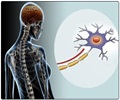The role of protein Rab32 in the impairment of mitochondrial dynamics and cell survival in multiple sclerosis has been identified.

- In the brains of people with multiple sclerosis (MS), there is the accumulation of massive amounts of protein Rab32.
- The Rab32 triggers endoplasmic reticulum (ER) stress that is the hallmark of neurodegenerative diseases such as multiple sclerosis (MS).
- This leads to the miscommunication between the endoplasmic reticulum and mitochondria, resulting in mitchondrial dysfunction and neuronal death.
The destruction of the protective myelin leads to exposure of the nerve fiber. This slows or blocks the messages that travel along that nerve. Eventually, the nerves can become permanently damaged.
There are more than 100,000 Canadians living with MS and the partially effective treatments aim to provide symptomatic relief by reducing inflammation and not curing the condition.
"Scientists have been pointing to the mitochondria, the powerhouse of the cell, as a possible link to MS, but have not been able to decipher how they malfunction. Ours is the first study that combines clinical and lab experiments to explain how mitochondria become defective in MS patients," said Thomas Simmen, study co-author and cell biology professor.
In addition to the disrupted mitochondrial dynamics, the endoplasmic reticulum (ER) stress is another hallmark of neurodegenerative diseases such as multiple sclerosis (MS).
The study team identified one protein, guanosine triphosphatase (GTPase) Rab32 that triggers endoplasmic reticulum (ER) stress within a cell, using human brain tissue samples of patients with MS.
The Rab32, a known regulator of the MAM, mitochondrial dynamics, and apoptosis, could be associated with ER stress as well as mitochondrial dysfunction.
"A part of the cell that stores calcium (ER or endoplasmic reticulum) gets too close to the part of the cell that creates energy (mitochondria) when massive amounts of Rab32 are present in the brain of MS patients. The resulting miscommunication with the calcium supply triggers the mitochondria to misbehave, ultimately causing toxicity for brain cells in MS patients," explained Simmen.
There is no Rab32 present in the brain tissue samples of healthy individuals.
The unwelcome influx of Rab32 could be due to the defect that originates at the base of the ER.
The scientists can now search for effective treatments that target Rab32.
"Rab32 is just one of the proteins that is having the effect of drawing the ER and mitochondria too close. There are dozens of other possibilities," Simmen said.
The research team is trying to identify more proteins that could be associated with multiple sclerosis.
The study, conducted with researchers at the University of Exeter, was recently published in the Journal of Neuroinflammation.
References
- Multiple sclerosis - (http://www.mayoclinic.org/diseases-conditions/multiple-sclerosis/home/ovc-20131882)
- Lori Chibnik et al. Rab32 connects ER stress to mitochondrial defects in multiple sclerosis. Journal of Neuroinflammation; (2017) DOI: 10.1186/s12974-016-0788-z
Source-Medindia














